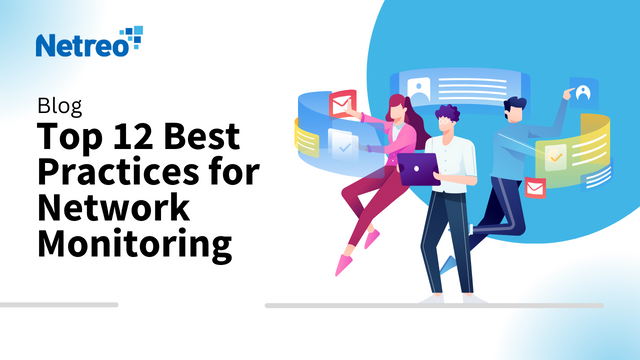
Network monitoring is a critical component in network management, ensuring that all systems and services are running smoothly. Monitoring a network involves continuously surveilling network components to detect any potential issues or performance bottlenecks that may arise. Doing so guarantees that the network’s performance remains at its peak, providing users with a seamless experience.

Why is network monitoring paramount? The answer lies in network monitoring’s ability to proactively identify problems, sometimes even before they impact end users. Identifying problems early reduces downtime, enhances performance, and results in a better user experience. Network monitoring is not just about keeping the network running; rather, network monitoring focuses on optimizing a network’s performance and ensuring it can handle the demands.
With this foundation laid, let’s dive into some network monitoring best practices to elevate your monitoring game.
Understanding what’s typical for your network first step in effective monitoring. To determine the typical behavior for your network, you must establish a baseline and metrics representing normal network behavior. With this baseline in place, any deviation becomes immediately apparent, making it easier to identify and address issues as they arise.
You might be wondering, “How do I establish this baseline?” Well, establishing a baseline starts with monitoring key performance indicators (KPIs) such as bandwidth usage, error rates, and response times over some time. Tools like full-stack monitoring solutions can be invaluable, offering a comprehensive view of your network’s performance. Additionally, automation tools can be beneficial for monitoring your KPIs and establishing your network’s baseline behavior. You can find relevant automation options on Netreo’s Automation Page.

Network downtime can be costly. Ensuring high availability is all about minimizing downtime and keeping your network up and running, no matter what. To ensure high availability and reduce downtime, implement redundant systems and pathways, ensuring that if one component fails, another can take its place without impacting the network’s overall performance.
Automation tools can play a crucial role here, helping to quickly identify issues and implement predefined solutions to keep the network running smoothly. A reliable automation solution can be a game-changer in maintaining network availability.
A network is made up of a myriad of devices and components, each playing a unique role in its overall performance. For you to truly understand your network’s health, collecting data from all network components is critical.
Collecting data from all network components includes monitoring routers, switches, servers, and any other devices that play a part in your network’s operation. You must pull in data from multiple sources, ensuring that you have a comprehensive view of your network’s performance.
Dashboards are a network administrator’s best friend, providing a real-time view of network performance at a glance. But a dashboard is only as good as its configuration. Configuring your dashboards to highlight the most important metrics is crucial, ensuring that you can quickly identify any issues and address them before they become critical.
Maintaining these dashboards is just as important, ensuring they provide accurate and relevant information as your network evolves. Tools like Netreo offer comprehensive dashboard capabilities.
When issues arise, time is of the essence. A documented escalation process ensures that the right people are notified immediately and that the issue is addressed as quickly as possible.
Having a thorough escalation process involves defining what constitutes an issue, determining who should be notified, and outlining the steps that should be taken to address the issue. Intelligent incident management tools can automate much of this process, ensuring issues are handled quickly and efficiently.
For insights on setting up an effective incident management process, refer to Netreo’s Incident Management Blog.
The right tools can make all the difference in network monitoring. This involves implementing tools that provide comprehensive monitoring, offer automated incident response, and deliver insightful analytics to help optimize network performance.
Automation plays a crucial role here, helping to reduce the manual workload on network administrators and ensuring that you can address issues quickly and efficiently. Tools that offer automation capabilities can streamline the network monitoring process, ensuring that your network remains in top condition.
For more information on automation, refer to 3 Keys to Automating IT Management.
Networks are multilayered, and issues can arise at any level. Creating detailed reports for each network layer ensures no stone is left unturned in the monitoring process, allowing for a thorough network health analysis.
Maintaining historical network performance data is crucial for trend analysis and capacity planning. Implement a data retention policy that balances the need for historical data with storage constraints, ensuring you have access to the correct data when needed.
An accurate and up-to-date network map is an invaluable tool for network monitoring. A network map provides a visual representation of the network, helping administrators quickly identify the location and nature of any network issues.
The technology landscape constantly evolves, and keeping abreast of new technologies and trends is essential. Ensure that your network monitoring practices remain practical and relevant and that you can leverage new tools and methodologies as they become available.

Documentation is the lifeblood of effective network monitoring. Ensure that all network configurations, policies, and procedures are well documented, and regularly update this documentation to reflect any changes in the network or organizational practices.
Identifying and monitoring the right KPIs is essential for effective network monitoring. These KPIs include network latency, packet loss, bandwidth utilization, and error rates. Keeping a close eye on these KPIs ensures you can quickly identify and resolve performance issues, maintaining optimal network health.
Refer to 7 Keys to Command Center Excellence for insights on identifying critical KPIs.
Effective network monitoring is not just about monitoring your network; rather, you need to proactively manage your network to ensure optimal performance. By establishing a baseline, providing high availability, collecting comprehensive data, maintaining dashboards, having a documented escalation process, and implementing the right tools and automation, you set the stage for a robust and resilient network.
Remember, a well-monitored network is a high-performing network. A high-performing network leads to happy users and a successful organization. And employing these 12 network monitoring best practices will put you well ahead of achieving both.
This post was written by Juan Reyes. As an entrepreneur, skilled engineer, and mental health champion, Juan pursues sustainable self-growth, embodying leadership, wit, and passion. With over 15 years of experience in the tech industry, Juan has had the opportunity to work with some of the most prominent players in mobile development, web development, and e-commerce in Japan and the US.